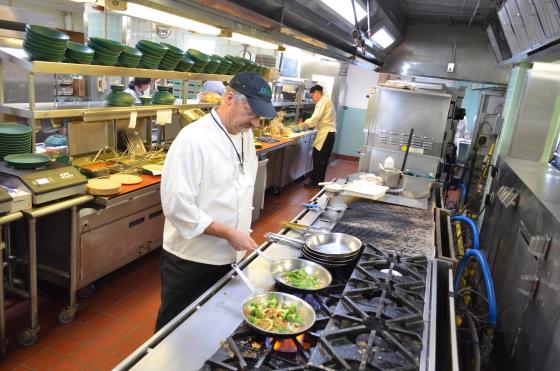Posted March 17, 2022 at 10:36am by Anonymous (not verified)
UVM Medical Center Advances Farm to Institution Goals

Written by Alison Nihart
New research from the University of Vermont has quantified the economic impact of local food purchasing by the University of Vermont Medical Center. This study, the first of its kind in the state, shows how Vermont’s largest hospital is contributing toward Vermont reaching its institutional consumption of locally-produced food goal in the Farm to Plate food system plan.
The research, a collaboration between Diane Imrie, director of Nutrition Services at UVM Medical Center, and UVM researchers Florence Becot and David Conner, was recently published the Journal of Foodservice Management & Education: Assessing the Impacts of Local Hospital Food Procurement: Results from Vermont.
Becot and Conner analyzed the hospital’s purchasing data from 2012 to understand how the impact of local food purchases rippled into the local economy. Their results show that the hospital’s $1.6 million in local food purchases contributed to $1.1 million in additional economic activity in Vermont in 2012. This occurs because local supply chains prevent economic “leakage” from the Vermont economy to companies outside the state.
The idea of economic leakage is based on the concept that a portion of any purchase from a company based outside Vermont will leave the state’s economy. Even the purchase of a local tomato at a chain grocery store, for example, inevitably results in some economic value leaving the state. Purchases from local producers and distributors, on the other hand, keep more of the money circulating locally. When you subtract the costs of production that go to purchasing inputs like fuel and imported fertilizers, a greater portion stays local.
Conner and Becot were able to quantify the portion that stays in the local economy by using economic modeling tools that estimate the value of money flowing into specific sectors of the economy. Due to an economic factor called the “multiplier effect,” they showed that every dollar UVM Medical Center spent on local food generated an additional $0.38 to $0.68 of value for the local economy.
During their research, Becot and Conner also discovered that the hospital serves in an important supply chain development role. Imrie and her colleagues help farmers transition into selling to wholesale markets by getting them up to speed, and then buying from them. For example, they have provided direct financing for infrastructure to increase a farm's production capacity.
Producers also obtain additional benefits from their association with the hospital: once a producer is an established vendor with the hospital, it sends a message to other potential buyers that the producer is wholesale ready. If a vendor has a successful relationship with a hospital, an institution that requires consistency and quality, this indicates they are sophisticated enough to sell to other wholesale buyers. In this way, the association with the hospital’s supply chain lends a certain prestige.
By helping producers prepare for wholesale markets, the UVM Medical Center also contributes to Farm to Plate local food production, market availability, and access to capital goals.
Imrie values the multiple benefits derived from these relationships. “We buy locally because we have the ability to personally interact with many local producers,” says Imrie. “This allows us to better understand the quality of their food, the challenges that they face as producers, and how we might be able to help. As an anchor institution in our community it is a very important role that we can play.”
Becot and Conner also learned that while patients are served from the same kitchens, the majority of the hospital’s customers eat at the hospital’s retail locations. Most of these are employees of the hospital, some are visitors to the hospital, and the remainder are UVM staff, faculty, and students who are drawn by convenience, quality of food, and low prices.
As a health care provider, UVM Medical Center hopes its emphasis on healthy meals, in addition to local purchasing, is supporting employee wellbeing, thereby additionally addressing Vermont’s Farm to Plate goal to reduce food-related health problems.
UVM Medical Center has received national recognition for its leadership in dining innovation. As one of the first hospitals in the country to sign the Healthy Food in Healthcare pledge, Imrie’s team has been thinking creatively for over a decade about how to move towards healthier, local, and sustainable menus. In 2013, the hospital won the “Sustainable Food Procurement Award” from Healthcare Without Harm, a national organization that promotes sustainability in healthcare institutions. This year, they were recognized with a “Silver Plate Award” from the International Foodservice Manufacturers Association.
Conner says studies like these can bring a sense of purpose and clarity to institutional foodservice local food programs. “Diane is a real leader in local food procurement,” said Conner. “This kind of study helps her understand where the hospital stands.”
Although the study focused on the economic impact within the state, Imrie sees this work rippling beyond Vermont. “This work can be replicated across the country and can shift our communities in a positive direction in terms of economics, farm viability, and health improvement.”
Learn more about the Center for Nutrition and Healthy Food Systems at UVM Medical Center.
